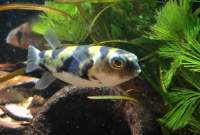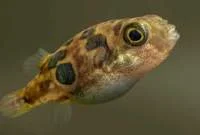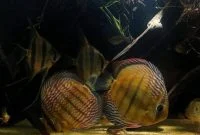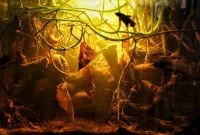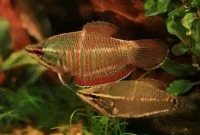Do siamese algae eaters eat black beard algae that are present in the planted tank? Most people who have a problem with this outbreak, especially the newer aquarists, search how to find ways to kill them. Many articles on the internet recommended keeping SAE (abbreviation from their name) against algae. We also suggested these fish protect your aquarium from black brush algae (BBA).
These fish belong to the Cyprinidae family, which is endemic fish from some regions in South East Asia. Nowadays, they are distributed to all countries in the world so that they can easily find them at nearby local aquarium stores.
Siamese algae eaters fish used in aquarium husbandry as a natural weapon to attack the present unwanted algae. Compared with other algae cleaners, these fish are more effective in killing most green algae types and red algae, known as a horrible plague.
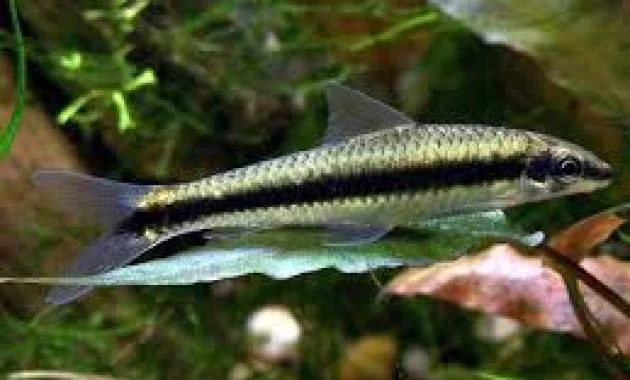
TABLE OF CONTENTS
Overview Siamese Algae Eaters
Most fish keepers assume Crossocheilus oblongus is a scientific name for siamese algae eater fish, but it is not entirely accurate.
The siamese algae eaters often sold in trades refer to a few freshwaters algae-eating fish under the Crossocheilus genus.
These genera consist of several species with similar appearance and characteristics, confusing most people in differentiating each other. So it’s not surprising many fish hobbyists frequently missapplied their names.
There are some species that are closely related and often sold under ‘Siamese Algae Eater, a.k.a Crossocheilus siamensis’ such as Crossocheilus oblongus, Crossocheilus langei, Crossocheilus reticulatus, Crossocheilus atrilime, Crossocheilus nigriloba, and Crossocheilus citripinnis. Basically, they need the same care requirements and graze on most algae types.
Siamese algae eaters, also called SAE fish, are active aquarium inhabitants; they can cover the tank entirely in a second. These fish can discover algae clumps faster than other powerful algae cleaners, which move slowly like zebra nerite snails.
These algae clean-up crews are easy to keep making SAE fish suitable for beginners. You can find them in most local aquarium stores due to popularitation and lower prices; each fish usually cost about $3-$5.
Origin And Natural Habitat Of Siamese Algae Eaters
Most siamese algae eaters are native to the Southeast Asian region. In the wild usually found inhabiting stream rivers and tributaries with a solid substrate like gravel, pebbles, boulders, and sand.
The water in these areas is commonly clear where the sunlight can penetrate the surface, and the dept level is often shallow.
These fish frequently occupy a dwelling place with many submerged driftwood and tree roots where aquatic plants and biofilm thrive well, covering the surface upon which they browse. Some were found colonized at reaches of rivers; the water is typically turbid with a muddy substrate.
Water in their habitat tends to be slightly acidic, and the current is tending not too fast. In nature, they spend most of their time finding food, hiding in their shelters, and primarily searching the algae. However, they also accept other things that sink into the floor of streams.
Siamese alga eaters are not great explorers fish; they tend to stay around refuges with which they are acquainted and infrequently browse up the water surface.
Appearance Of Siamese Algae Eaters
These freshwater fish algae cleaners can be identified by their bold dark stripes that run from the snout to the tip of the caudal fin. Their base color is predominantly greyish to silvery, allowing them to camouflage with the stones. Some species have different color combinations like tan, tawny yellow, or reddish brown.
You may find their black stripes start to fade; this usually occurs when they feel stress, during the mating process, and in order to camouflage with their settle from the predators (it rarely happens in aquarium environments).
They have aerodynamic bodies which are slender and long, referring to tiny sharks. It is designed to help these fish swim in strong-flowing water areas.
All species named siamese algae eaters have two small barbels that develop on the upper lips. This helps these fish detect any smallest prey hanging around on the substrate, also helping them feel changes in water pressure and chemical rates.
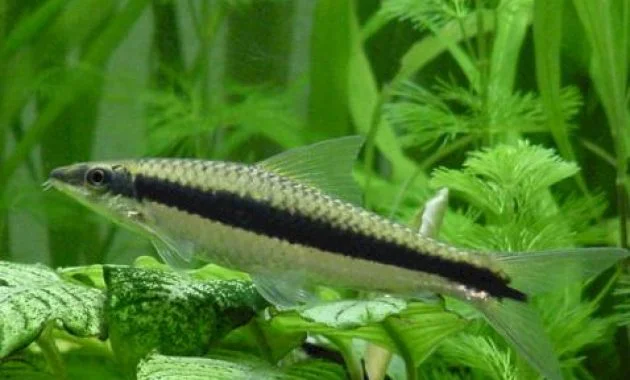
BUY LIVE HEALTHY AND HIGH QUALITY SIAMESE ALGAE EATERS FISH ONLY ON AMAZON
Tropical SAE fish has sucker mouth that allows them to munch algae optimally; their snout is pointed. They have six transparent and colorless fins over their body. There are two pectoral fins under their gills, then a pelvic fin on the abdomen. After that, their anal fin sits under their genital organ and is followed by a forked or V-shaped tail fin at the caudal peduncle as well as a triangular dorsal fin at their back.
How big do siamese algae eaters get? Most SAE species grow maximumly about 5-6 inches (14-15 centimeters). However, they typically sold in ranges between 2-2.5 inches on the trades.
It’s too difficult to tell the distinction between males and females before they reach around 3-4 years old. Once they achieve this age, the only thing that becomes a sign to identify their sexuality is their size. Females are slightly larger than males, generally about 30% bigger in mass.
Dissimilar to most freshwater-planted aquarium fish, siamese algae eaters do not have a swim bladder. So, they should be moved constantly to stay afloat in the water, and their body shape is designed to help them with this condition.
How long do siamese algae eaters live? In captivity, they can live up to 10 years in good condition and with proper care. The wild species probably find it hard to achieve this age due to changes in the environment and their predators.
Siamese Algae Eater’s Behaviour And Temperaments
Are siamese algae eaters aggressive fish? Actually, they are peaceful live stocks; nonetheless, in particular conditions, they might be slightly aggressive, especially when kept in a small group of around 2-3 individuals. Its possible aggression occurs each other due to asserting territories in the aquarium. Although in the smaller group, they tend to be in conflict with each other, these fish will shoal peacefully in larger numbers; at least you must keep 4-5 individuals. Sometimes, you will see them eating together in the same place.
They are faster swimmers and energetic; SAE fish probably do not strike other species, but their movement behavior might disturb and annoy any quieter species, such as discus.
These freshwater algae cleaner fish tend to spend most of their time swimming around at the bottom level of the aquarium until finding algae spots, then probably sit there for a while until this snack is gone.
Occasionally, SAE fish climb the wall glass by sticking their mouth sucker while grazing the algae that develop there. This is how these Asian tropical aquarium fish reach the middle and upper zones of the tank.
When they sleep, siamese algae eaters usually prop up their bodies on the leaves or other objects, then let their tails swing back and forth even while part of their upper body is still. So, if they stop moving at all, these sucker fish will fall to the tank floor.
Types Of Siamese Algae Eaters
How many siamese algae eaters are species that are usually available in the aquarium trades? There are several different SAE fish species that are pretty difficult to tell them apart.
Crossocheilus Langei
C. Langei, also known as ‘Red Algae Eater.’ These siamese alga eater species have a single dark laterally-striped at the middle of their body that runs from the head to the tail with reddish brown with a light-colored underside. Their body size is large, with a cigar-like shape and spots on the belly.
They have a pair of eyes that are reddish-golden above the pupil and white below. Crossocheilus langei’s barbels are longer rather than other varieties, and they are brownish.
Crossocheilus langei are native to peninsular Malaysia, Borneo, Southern Myanmar, and western and southern Thailand. The first specimen is found in Palembang, Sumatra Island, Indonesia.
These SAE fish varieties inhabit clear water, while they might be found in turbid, deeper water during seasonal migrations.
C. langei are known as the most efficient siamese algae eater fish for consuming algae. They can clean stubborn forms such as black beard algae (BBA) and staghorn, while some reports said that they only do well with younger ones, which have a gentle texture and should be introduced to it before the plague is come about.
Crossocheilus Atrilimes
This member is slightly easy to diagnose; they are one of the smaller siamese algae eaters with an adult’s size only between 7-7.5 centimeters. The young Crossocheilus Atrilimes has spindle shape body.
Their dark band is extended, reaching the posterior tip of median tail fin rays. C. Atrilimes come with tan or yellow body color and yellowish fins. Crossocheilus Atrilimes originate from Cambodia and Thailand; they usually can be discovered throughout the Chao Phraya and Mekong drainages.
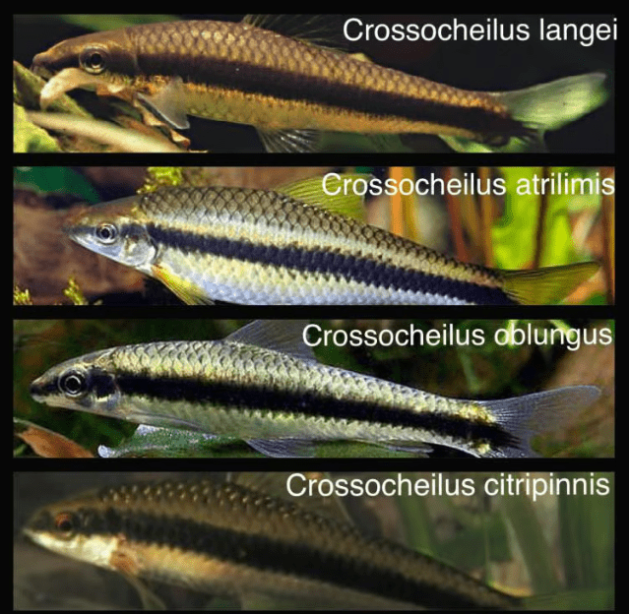
Crossocheilus Oblongus
Most aquarium dealers commonly label siamese algae eater Crossocheilus Oblongus; however, we don’t know if it’s valid or not. According to an article from seriouslyfish.com, C. Oblongus is described as an SAE fish variety with a blueish color body with yellow fins and inhabited the water systems throughout Sunda islands and Indochina. The appearance and size of the adult form of this species are kind of between C. Langei and C.artilimes.
Crossocheilus Citripinnis
This is a larger siamese algae eater species; they can grow up to 15 cm SL and have a couple of maxillary barbels that are visible clearly.
Their fins are lemon yellow, which may become stronger when they mature. The dark band does not change in width or color when they are fighting, and the lateral line shape curve.
C. citripinnis body form is like C. Atrilimes’; this means they will be confused about identifying when both are in the juvenile phase.
Crossocheilus Reticulatus
C. reticulatus is most different species from others; they are easy to recognize from their striking appearance where they do not have a lateral black line across the body; instead, they have a blotch at the caudal peduncle.
Their appearance is fantastic; comes with a combination of brown, yellow, and silvery body color with a dark tint at the edge of the scales.
In the aquarium world, they are commonly offered as reticulated algae eaters or fishnet flying fox due to their color mimic to a net-like pattern. Crossocheilus reticulatus is a larger member of their genus, and the adult fish reach up to 16-17 centimeters.
In nature, they can be collected throughout the Mekong basin and Chao Praya river drainage, Yunan province of China, and also found in other Southeast Asian countries such as Vietnam, Laos, and Cambodia.
Crossocheilus Nigriloba
At a glance, they look like C. Oblongus, which has blueish color. However, their black lateral black stripe turns into a series of blotches when they are sparring, sleeping, and stress. As an additional sign, this species has dark pigmentation suffused with red color at the lower of the caudal fin lobe. From this mark, Crossocheilus nigriloba have their own common name as ‘penguin flying fox’ on fish trades.
C. nigriloba are endemic tropical fish species from Kalimantan, part of the Indonesian island. They usually settle Kapuas basin and Sentarum lake in Kalimantan Barat; these fish also occurs in Mahakam and Belayan river systems in Kalimantan Timur. Penguin flying fox can probably be found in Kalimantan Selatan and Kalimantan Tengah provinces, but there are still no detailed data until now.
Crossocheilus Siamensis
This variety is the true siamese algae eater fish. Unfortunately, it’s very hard to find them on the trade. C. Siamensis have a thicker dark band and silvery body color, their snout is sharply pointed, and the lip is V-shaped.
Siamese Algae Eaters Diet And Feeding
As their name suggests, algae are primarily their diet. In nature, they also accept plant matter, small insects, phytoplankton, microorganisms, and anything they find.
SAE fish are not picky eaters, so providing food in aquarium environments will be easier. They will accept some dried food varieties you buy in fish shops, like algae wafers, flakes, pellets, and live or frozen meals. Some vegetables such as spinach, broccoli, cucumbers, and carrion also would be bitten by them.
Do siamese algae eaters eat the tougher algae like black beard algae?
Of course, they feed on it. The younger siamese algae eater fish consume more black brush algae rather than adult ones. The bigger SAE fish can still do their job cleaning aquariums as long as they do not overfeed.
They also do great in wiping out other stubborn red algae types, such as brown and staghorn. Green hair algae are the most their favorite snacks; other forms of green algae, like green spot and green dust algae, are also munched by them. They prefer a gentle texture like young and dying algae.
Live or meaty food would be better if given once or twice weekly. Feeding it too much can trigger severe problems like digestive issues. If they find pesky bugs or worms like gammarus, planaria, hydra, and detritus worm in the aquarium, siamese algae eater will devour them before it disrupts.
Overfeeding is a terrible practice; it can have the worst impact on the ecosystem and their health. The leftover food can build up at the substrate, stimulating many problems like algae, fungus, bacteria, and pests. It also reduces their feeding habit when they already eat some algae sticking on aquatic plants; after that, you give too much additional food. Sometimes SAE fish would stop consuming algae in favor of another food.
Setting Up Aquarium For Siamese Algae Eaters Fish
A single siamese algae eater fish requires a minimum tank size of about 20 gallons of water. If you want more live stocks, add 10 gallons of water for each specimen. So, if you have a 30-gallon aquarium in your home, it can accommodate two fish; if it is 50-gallon, you may put four large SAE.
Avoid using rough gravel; it could scar their body and hurt their sensitive barbels. As bottom-dwelling, these fish often swim around the tank floor; utilizing soft sandy substrate like AquaNatural’ Sand is safer for them. You can combinate it with fine light-colored pebbles, making your tank replicate their natural habitat more.
Planting some aquatic plants are necessary. They are one of the perfect media for algae establishment, which is SAE’ favorite snack. Aquarium plants also take an essential role in absorbing carbon dioxide in the water, turning it into dissolved oxygen for fish. Besides, if you arrange them well, your tank will present an incredible view, making any people who look that enjoy sitting in front of it for a long time.
Large-leaved aquatic plants are excellent for algae such as microsorum, cryptocoryne, and anubias species. Covering the surface with some floating vegetation like salvinia natans or azolla cristata. This can prevent the SAE fish from jumping out from the tank and create shady areas inside the aquarium.
Indeed, they do not need any specific water flow rates, remembering siamese algae eaters naturally are river inhabitants. However, creating a similar artificial environment in the aquarium would make them live more passionately. Installing a canister filter and setting the water current at a slow-moderate level replicating to river bed condition. The filtration system aims to control the water quality by cycling the organic and non-organic waste.
There is no special requirement for lighting intensity. They can live well under various levels; instead, adjust it as your plants need due to lighting rate and period affecting their growth.
Keep the water temperature around 75-80°F (23-26°C), utilization of a heater is optional, but slightly warmer water is advised. To monitor the warm level, you should apply an aquarium thermometer. Ideally, the PH level ranges between 6.5-7.0, but they can still tolerate a slightly broader span of about 6.0-8.0 if required. The water hardness level should be between 5-20 dH.
Adding some hardscape like rocks, driftwood, and roots are recommended. This will recreate their natural habitat, providing more hiding places and algae development media and encouraging their health due to tannins released from submerged wood parts.
They would appreciate other decorations such as artificial plants, caves, leaf litter, and other aquarium ornamentals. Remember, they are an active fish species that need open areas for swimming. An arrangement of easy-accessible hiding spots in the aquarium will make them more comfortable.
Cover your fish tank with a tight canopy to prevent them from jumping out because SAE fish are active swimmers.
How To Keep And Take Care of Siamese Algae Eaters
The primary point to keep them healthy is water quality and water cleanliness. Water changing about 30% of tank volume on a regular basis every two weeks is suggested to reduce the buildup of pollutants.
Sucking up the organic and non-organic waste on the tank floor using gravel cleaners. Scrub the hardscapes, decorations, and aquarium equipment; since you are keeping siamese algae eaters, you can leave your tank without being too clean to trigger the algae to grow there.
Be careful when adding new plants, live stocks, and decorations from another aquarium. It may take toxins, and the water from there probably contain diseases.
Do not put too many plants and decorations, making your planted tank overcrowded; it will hamper these fish in motion.
Ensure you do not overpopulate your aquascape tank with too many SAE fish. Even if they are an excellent algae remover species, remember that any fish variety, including them, generates feces that can make your tank dirty.
Can You Breed Siamese Algae Eaters In Home Aquarium?
It’s almost impossible to reproduce these fish in home aquaria with the standard setting, even though their spawning ways are similar to other freshwater fish species.
Maybe, it is hard to tell the species apart because they are difficult to breed by fish hobbyists, even by expert aquarists too. The different species of siamese algae eaters generally can not interbreed, even if they are mating; it rarely happens and can occur if through artificial spawning. Still, the gender characteristics will be visible until the fish age reaches at least three years old.
Furthermore, information about breeding habits and conditions is still not well known, so it is very challenging to duplicate it in the aquarium environment. While the information that we found out is that siamese algae eater fish will make migrate to the part of driest rivers to spawn and lay their eggs there, concurring with the dry season. Once again, this is almost impossible to replicate in the home breeding tank or even in captivity.
Until this article was written, there were still no reports from aquarists or hobbyists that successfully breed them in home aquaria. Although these fish are egg scatterers; however their pregnancy period, nest size, and caring requirements for larvae and SAE babies are still unrecognized.
While the commercial siamese fish that is usually offered on the trades is made from artificial insemination, hormone injection, and pheromones, of course, the required tools for this are not cheaper and hard to obtain.
Siamese Algae Eater Tankmates
Remember, they are bottom-dwellers. You need to think again about what kind of species will live there. Some similar fish might be territorial and launch aggression at them when they come across. Freshwater red-tail sharks are an example; the adult ones often bully other fish into guarding their territory. However, Roseline and apollo sharks are exceptional due to their peaceful characteristics.
Do not add larger and more aggressive fish because they can strike or even eat your SAE fish. Commonly, the tropical fish varieties that live in other zones in the tank won’t have any territory conflict.
Chinese algae eaters, siamese flying fox, plecos species, and pictus cats should not be kept together with them. Your fish may be outcompeted, and sometimes they might attack them.
Below are good candidates for their tankmates
- Corydoras catfish species
- Kuhli loaches
- Danios species
- Tetra species
- Mollies
- Guppies
- Platies
- Tetras species
- Angelfish
- Paradise gourami
- Barbs
- Licorice gourami
- Three spots gourami
- Pearl gourami
- Sparkling gourami
- Pea puffers
- Honey gourami
- Dwarf gourami
Their tankmates should not only be fish but other aquarium creatures such more giant crustaceans (Amano and bamboo shrimps) and aquatic mollusks like nerite, ramshorn, inca, rabbit and apple snails, also suitable for siamese algae eaters.
Common Problems And Possible Diseases
In general, they do not prone to a specific species of disease; however, they still can be affected by common fish illnesses like ich, fungus, pop eyes, and others.
Most fish sicknesses have medicines and treatment methods; this will work more appropriately when combined with quarantine tanks. Nonetheless, several ways can prevent your fish from getting illness where practiced some caring guides above.
It would be best if you were selective in choosing additional food types; the cheaper ones sometimes can cause constipation to your siamese fish and frequently leads to further effects.
Flying Fox Fish VS Siamese Algae Eaters
The flying fox fish’s body color is more yellow, with two black bands that run from the snout to the tail that is smooth, while their fins are darker.
Grow up to six inches with body shapes that are flatter and thinner rather than SAE fish. Their barbels are more prominent, with tiny fleshy flaps on both sides of their mouth.They avoid red algae but love grazing on green algae and accept other food types like tablets, flakes, and others.

The siamese algae eater’s body color is lighter than flying foxes, with the black stripe being a bit broken up with jagged edges, and their fins are colorless. Grow optimally up to 6 inches with a pointed body shape, the thickest part in the middle near their dorsal fins.
Their barbels are too tiny, almost invisible, and do not have flaps. They are excellent for red algae removal.
Common Question About Siamese Algae Eaters
Do siamese algae eaters eat plants?
In nature, they usually consume plant matter. Crossocheilus atrilime tends to prefer to fine-leaved plants such as vesicularia, but most SAE species often prefer algae.
Do siamese algae eaters eat snails, shrimps, or even fish?
They also accept proteins as part of their needs. They commonly hunt smaller creatures like tiny insects, shrimplets, fish fry, and snail babies in their habitat. So, we suggested not keeping them together with smaller crustaceans like red cherry shrimps or tiny nerite snails.
Can siamese algae eaters live with goldfish?
Both fish should not be put in the same tank for a few reasons. Goldfish release slime coats across their body; sometimes, algae eaters can be annoyed by slurping it. If this leave for some while, your goldfish may be susceptible to illness. Furthermore, it probably occurs a competition in dominating algae clumps; remember, it is also one of goldfish’s diet.
Can siamese algae eaters live with bettas?
Of course, they can live together, even though the betta fish is popularly known as an aggressive and territorial species, but they can be nice tankmates. Betta fish often spend the whole day floating at the top of the aquarium, while the siamese algae eaters inhabit the lower areas; as a result, conflict rarely happens.


